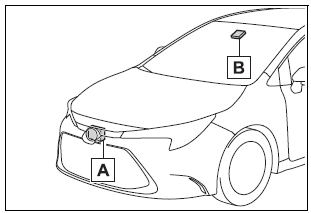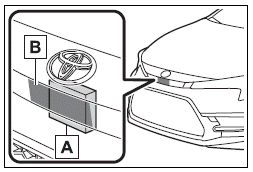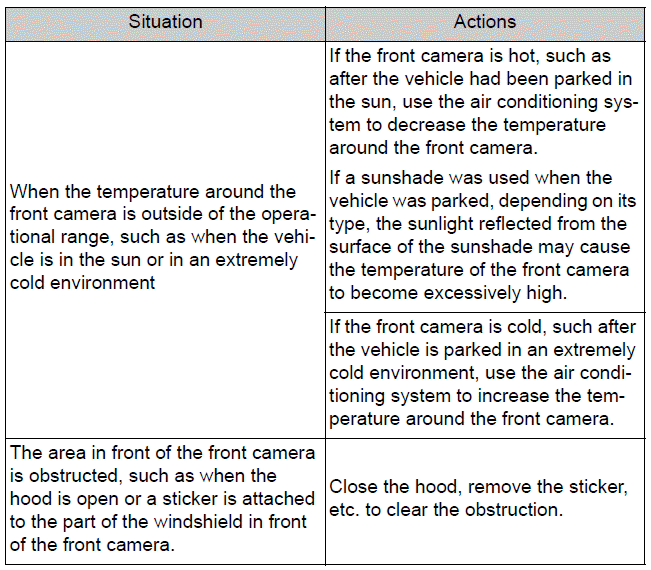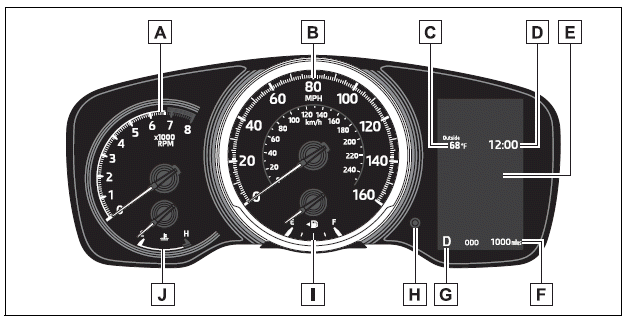Toyota Corolla: Toyota Safety Sense 2.0 / Sensors
Two types of sensors, located behind the front grille and windshield, detect information necessary to operate the drive assist systems.

A - Radar sensor
B - Front camera
WARNING
■To avoid malfunction of the radar sensor
Observe the following precautions. Otherwise, the radar sensor may not operate properly, possibly leading to an accident resulting in death or serious injury.
- Keep the radar sensor and the radar sensor cover clean at all times.
u 1.8 L 4-cylinder (2ZR-FAE) engine

A - Radar sensor
B - Radar sensor cover
If the front of the radar sensor or the front or back of the radar sensor cover is dirty or covered with water droplets, snow, etc., clean it.
Clean the radar sensor and radar sensor cover with a soft cloth to avoid damaging them.
u 2.0 L 4-cylinder (M20A-FKS) engine

A - Radar sensor
B - Radar sensor cover
If the front of the radar sensor or the front or back of the radar sensor cover is dirty or covered with water droplets, snow, etc., clean it.
Clean the radar sensor and radar sensor cover with a soft cloth to avoid damaging them.
- Do not attach accessories, stickers (including transparent stickers) or other items to the radar sensor, radar sensor cover or surrounding area.
- Do not subject the radar sensor or its surrounding area to a strong impact. If the radar sensor, front grille, or front bumper has been subjected to a strong impact, have the vehicle inspected by your Toyota dealer.
- Do not disassemble the radar sensor.
- Do not modify or paint the radar sensor or radar sensor cover.
- In the following cases, the radar sensor must be recalibrated. Contact
your Toyota dealer for details.
- • When the radar sensor or front grille are removed and installed, or replaced
- • When the front bumper is replaced
■To avoid malfunction of the front camera
Observe the following precautions. Otherwise, the front camera may not operate properly, possibly leading to an accident resulting in death or serious injury.
- Keep the windshield clean at all times.
- • If the windshield is dirty or covered with an oily film, water droplets, snow, etc., clean the windshield.
- • If a glass coating agent is applied to the windshield, it will still be necessary to use the windshield wipers to remove water droplets, etc. from the area of the windshield in front of the front camera.
- • If the inner side of the windshield where the front camera is installed is dirty, contact your Toyota dealer.
- Do not attach objects, such as stickers, transparent stickers, etc., to the outer side of the windshield in front of the front camera (shaded area in the illustration).

A - From the top of the windshield to approximately 0.4 in. (1 cm) below the bottom of the front camera
B - Approximately 7.9 in. (20 cm) (Approximately 4.0 in. [10 cm] to the right and left from the center of the front camera)
- If the part of the windshield in front of the front camera is fogged up or covered with condensation, or ice, use the windshield defogger to remove the fog, condensation, or ice. (®P.417, 422)
- If water droplets cannot be properly removed from the area of the windshield in front of the front camera by the windshield wipers, replace the wiper insert or wiper blade.
- Do not attach window tint to the windshield.
- Replace the windshield if it is damaged or cracked. After replacing the windshield, the front camera must be recalibrated. Contact your Toyota dealer for details.
- Do not allow liquids to contact the front camera.
- Do not allow bright lights to shine into the front camera.
- Do not dirty or damage the front camera. When cleaning the inside of the windshield, do not allow glass cleaner to contact the lens of the front camera. Also, do not touch the lens. If the lens is dirty or damaged, contact your Toyota dealer.
- Do not subject the front camera to a strong impact.
- Do not change the installation position or direction of the front camera or remove it.
- Do not disassemble the front camera.
- Do not modify any components of the vehicle around the front camera (inside rear view mirror, etc.) or ceiling.
- Do not attach any accessories to the hood, front grille or front bumper that may obstruct the front camera. Contact your Toyota dealer for details.
- If a surfboard or other long object is to be mounted on the roof, make sure that it will not obstruct the front camera.
- Do not modify the headlights or other lights.
■If a warning message is displayed on the multi-information display
A system may be temporarily unavailable or there may be a malfunction in the system.
- In the following situations, perform the actions specified in the table. When the normal operating conditions are detected, the message will disappear and the system will become operational.
If the message does not disappear, contact your Toyota dealer.


- In the following situations, if the situation has changed (or the vehicle has been driven for some time) and the normal operating conditions are detected, the message will disappear and the system will become operational.
If the message does not disappear, contact your Toyota dealer.
- When the temperature around the radar sensor is outside of the operational range, such as when the vehicle is in the sun or in an extremely cold environment
- When the front camera cannot detect objects in front of the vehicle, such as when driving in the dark, snow, or fog, or when bright lights are shining into the front camera
 PCS (Pre-Collision System)
PCS (Pre-Collision System)
The pre-collision system uses a radar sensor and front camera to detect objects
(®P.206) in front of the vehicle. When the system determines that the possibility
of a frontal collision with an object is high, a warning operates to urge the driver
to take evasive action and the potential brake pressure is increased to help the
driver avoid the collision...
Other information:
Toyota Corolla 2019-2025 Owners Manual: Rear seats
The seatbacks of the rear seats can be folded down. Folding down the rear seatbacks 1 Move the front seats forward. (®P.133) 2 Stow the rear armrest. (if equipped) (®P.443) 3 Seats with an adjustable type head restraint: Lower the head restraints to the lowest position...
Toyota Corolla 2019-2025 Owners Manual: If the engine will not start
If the engine will not start even though correct starting procedures are being followed, consider each of the following points: The engine will not start even though the starter motor operates normally. One of the following may be the cause of the problem: There may not be sufficient fuel in the vehicle’s tank...
Categories
- Manuals Home
- 12th Generation Corolla Owners Manual
- Alarm
- Sensors
- Lubrication system (1.8 L 4-cylinder [2ZR-FAE] engine)
- New on site
- Most important about car
Gauges and meters (4.2-inch display)
Meter display
■ Locations of gauges and meters

The units of measure may differ depending on the intended destination of the vehicle.
A - Tachometer Displays the engine speed in revolutions per minute

